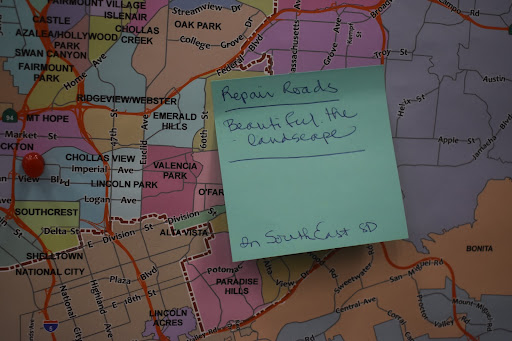
By Macy Meinhardt, Voice & Viewpoint Staff Writer
Residents and non-profit organizations of the community gathered Saturday to discuss their vision on how they would like to see $135 million of federal Housing and Urban Development Funding (HUD) to be spent over the next five years.
Every five-years, the City of San Diego compiles a consolidated plan document to identify community needs and priorities. The consolidated plan is a combination of data and community outreach that determines top housing needs, community development concerns, and gaps in supportive services for low and moderate income populations.
For the 2025-2029 plan, San Diego’s economic development team and city consultants engaged with residents and local nonprofit organizations, including the Black American Political Association’s SD chapter, (BAPAC) in recent open forums.
Serving as the forums host, BAPAC’s efforts work to ensure the economic, social, and political force of the Black community in San Diego remain relevant. Leading the Oct. 21 forum was David P. Dollahan of DPD solutions who serves as the city’s five year plan consultant. In addition, Abena Bradford served as the moderator on behalf of BAPAC, whose nonprofit members were also in attendance to advocate for HUD funding to be prioritized for their community. Affordable housing, street-repair, homelessness, equity, job opportunities, and sustainability were some of the many topics brought up for funding allocation.
Bradford, who also serves as chair for the consolidated plan advisory board, spoke on the importance of non-profit collaborative efforts with government. “Nonprofits provide services to the community that the government sometimes can not reach. That’s how important non-profits are, and that’s why it is important we have an opportunity to make a contribution and let our voices be heard,” said Braford.
Dollahan broke down the four main funding sources within the $135 million of HUD funds for the audience members to consider. These areas include the Community Development Block Grant, which is designed to improve low to moderate income communities. The Home investment Partnership Program, which regards affordable housing creation, the Emergency Solutions Grant, which targets getting people removed from homelessness. And lastly, the Housing Opportunities for Persons with AIDS program, which connects people’s housing with medical social support services.
“These are the four preeminent housing programs that the community, I feel, gets to have a say in how the money is spent and where it goes,” said Dollahan.
Although known for our sunny beaches and thriving economy, for years San Diego has been in the midst of a dual crisis as we grapple with both a housing shortage and a rising homelessness problem. While city leaders such as Councilmember Stephen Whitburn promised in 2020 campaign elections that “At the end of my term, there will be very few people left unsheltered in San Diego,” the numbers tell a different story. In fact, between 2021 to 2022, homelessness rates rose by 22 percent.

Multiple homelessness advocates came out to the forum to speak on where local and national funding priorities should be allocated to, but are not currently.
“I just want to put this into the atmosphere. We find $9 billion for war. I don’t want anybody to tell me there is never enough money for homeless people. There is always enough money to do what people want to do, but never enough money to do what we need to do,” said one attendee.
“There are plenty of mechanisms out there to identify funding sources that require a political will to be changed at the local levels,” said Dollahan, in response. With the District 4 special election coming up Nov. 7, the city consultant emphasized the significance of actively participating and staying informed in local government and nonprofit organizations—as these are the crucial areas where citizens can have the greatest impact on their community.
Meanwhile, other community members spoke on the premise of affordable housing. The city’s soaring housing costs, in combination with limited affordable options, have forced many residents out of their homes. In addition, waitlists for section-eight housing are incredibly long within the city. According to the San Diego Housing Commission, current waitlists are at approximately twelve years. Selecting funding prioritization into programs such as Home Investment Partnership Program can help streamline that process.
Furthermore, the forum also hosted a series of activities for attendees to participate in at the end to help the Economic Department solicit further input. In addition residents were also directed to fill out a survey that asked residents to rank service need priorities.
“Share it with your families, share it with your friends, share it with people who own businesses in San Diego, share it with your employees, share it with everyone,” Dollahan encouraged.
The survey link can be accessed by scanning your device over the QR code attached to this article. The link will take users to the city’s Consolidated Plan webpage. Survey can be found by scrolling down to the “Community Needs Survey” section. Input gathered from the surveys and series of forums will be implemented into the drafting process, which is expected to be published in March of 2024. In that time residents will be asked back again to give their feedback and critiques on the draft before the final document is submitted.


